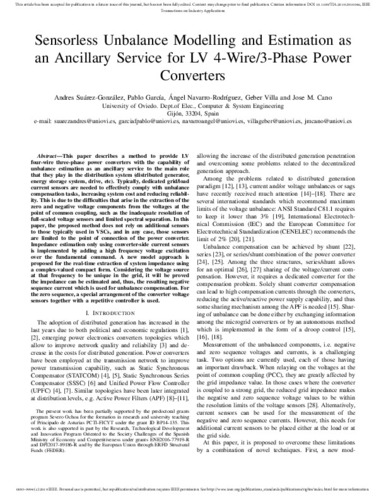Sensorless Unbalance Modelling and Estimation as an Ancillary Service for LV 4-Wire/3-Phase Power Converters
Fecha de publicación:
Editorial:
IEEE
Versión del editor:
Citación:
Resumen:
This paper describes a method to provide LV four-wire three-phase power converters with the capability of unbalance estimation as an ancillary service to the main role that they play in the distribution system (distributed generator, energy storage system, drive, etc). Typically, dedicated grid/load current sensors are needed to effectively comply with unbalance compensation tasks, increasing system cost and reducing reliability. This is due to the difficulties that arises in the extraction of the zero and negative voltage components from the voltages at the point of common coupling, such as the inadequate resolution of full-scaled voltage sensors and limited spectral separation. In this paper, the proposed method does not rely on additional sensors to those typically used in VSCs, and in any case, those sensors are limited to the point of connection of the power converter. Impedance estimation only using converter-side current sensors is implemented by adding a high frequency voltage excitation over the fundamental command. A new model approach is proposed for the real-time extraction of system impedance using a complex-valued compact form. Considering the voltage source at that frequency to be unique in the grid, it will be proved the impedance can be estimated and, thus, the resulting negative sequence current which is used for unbalance compensation. For the zero sequence, an especial arrangement of the converter voltage sensors together with a repetitive controller is used.
This paper describes a method to provide LV four-wire three-phase power converters with the capability of unbalance estimation as an ancillary service to the main role that they play in the distribution system (distributed generator, energy storage system, drive, etc). Typically, dedicated grid/load current sensors are needed to effectively comply with unbalance compensation tasks, increasing system cost and reducing reliability. This is due to the difficulties that arises in the extraction of the zero and negative voltage components from the voltages at the point of common coupling, such as the inadequate resolution of full-scaled voltage sensors and limited spectral separation. In this paper, the proposed method does not rely on additional sensors to those typically used in VSCs, and in any case, those sensors are limited to the point of connection of the power converter. Impedance estimation only using converter-side current sensors is implemented by adding a high frequency voltage excitation over the fundamental command. A new model approach is proposed for the real-time extraction of system impedance using a complex-valued compact form. Considering the voltage source at that frequency to be unique in the grid, it will be proved the impedance can be estimated and, thus, the resulting negative sequence current which is used for unbalance compensation. For the zero sequence, an especial arrangement of the converter voltage sensors together with a repetitive controller is used.
Patrocinado por:
The present work has been partially supported by the predoctoral grants program Severo Ochoa for the formation in research and university teaching of Principado de Asturias PCTI-FICYT under the grant ID BP14-135. This work is also supported in part by the Research, Technological Development and Innovation Program Oriented to the Society Challenges of the Spanish Ministry of Economy and Competitiveness under grants ENE2016-77919-R and DPI2017-89186-R and by the European Union through ERFD Structural Funds (FEDER).
Colecciones
Ficheros en el ítem




